Benefits of Unilateral Exercises
In addition to balancing out both sides of the body, single-leg (unilateral) exercises work the deep lateral stabilizers of the hip and core in ways we can’t duplicate with bilateral moves. There’s also more carryover to normal ground-based movements like walking, skipping and running than you have with bilateral exercise. Try adding a few of the following exercises into your regular weight-training regimen for better balance and greater strength.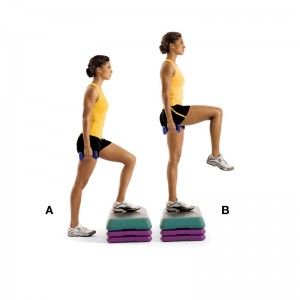
1. Step-Ups
Step-ups target the glutes and hamstrings as well as the quadriceps.
HOW TO DO THEM:
- Stand with a 12- to 18-inch plyo box or bench at your right side and your right foot on the box.
- Step up onto the box with your left foot while straightening the hip and the knee of your right leg. Root through your right heel to lift the rest of your body and raise the left knee until both your left hip and knee reach a 90-degree angle.
- Step down with the left leg by bending the hip and knee of the right leg.
- Repeat with the right leg for 10 to 15 repetitions, and then turn to face the opposite direction and perform the entire routine with the left leg.
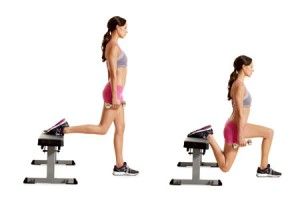
2. Bulgarian Split Squat
This one-legged squat resembles a lunge, except the non-working leg is propped up on a bench for balance. It works the quadriceps and glutes.
HOW TO DO IT:
- Start by standing about two to three feet in front of a flat bench with your back to the bench.
- Reach one foot back so that your toes rest on the bench. Your other foot should be planted in front of you.
- Keep your head up, back straight and chest out while performing this exercise.
- As you inhale, slowly lower your back knee until your front thigh is parallel to the floor.
- At this point, your knee should be directly over your toes.
- Lift your knee back to the starting position as you exhale.
- Repeat for 10 to 15 repetitions.
- Switch legs and repeat the movement.
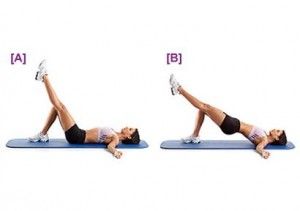
3. Single-Leg Glute Bridge
This exercise may be done either with your feet flat on the floor or up on a bench. It primarily works the glutes and hamstrings.
HOW TO DO IT:
- Lie on the floor with your feet flat and knees bent.
- Raise one leg off the ground, pulling your knee to your chest.
- Push through your heel, raising your hips off the ground and extending them upward. Extend as far as possible and pause at the top, then return to the starting position.
- Repeat for 10 to 15 repetitions.
- Switch legs and repeat the movement.

4. Single-Leg Romanian Deadlift
A unilateral version of a traditional stiff-legged deadlift, this move requires balance and core stability and works the glutes, hamstrings and spinal erectors.
HOW TO DO IT:
- Stand on your right leg while holding a dumbbell at your side in your right hand.
- Keeping the right knee slightly bent, perform a stiff-legged deadlift by bending at the hip, extending your free leg behind you for balance or resting the top of your foot on a bench.
- Continue lowering the dumbbell until your upper body is parallel to the ground, and then return to the upright position.
- Repeat for 10 to 15 repetitions.
- Switch legs and hands and repeat the movement.
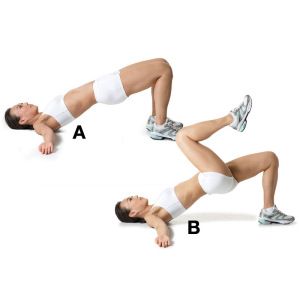
5. Single-Leg Hip Pops
This challenging exercise primarily targets the hamstrings of the supporting leg. It is a great hamstring exercise both bilaterally and unilaterally, with the additional benefit in the single-legged movement of hip rotators and stabilizers.
HOW TO DO THEM:
- Start seated on the ground with your legs extended in front of you and your feet flexed.
- Place your hands on the ground next to your hips with your fingers pointed toward your feet.
- Raise and hold your left leg just a few inches off the ground. Then push your right heel into the ground, and with the arms extended and supporting your weight on your hands, lift your hips as high as possible in a straight-body position.
- Lower your hips back to the starting seated position, then quickly and explosively pop them back up.
- Strive for 10 to 12 reps each side.
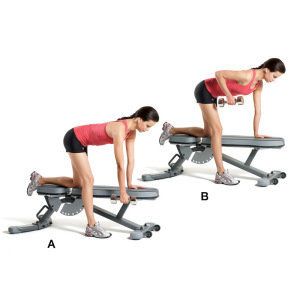
6. One-Armed Dumbbell Row
This one-sided back exercise targets the latissimus dorsi, trapezius, rhomboids and forearm flexors, including the biceps muscles. Keep your core engaged throughout the movement to stabilize and support your back.
HOW TO DO IT:
- Grab a dumbbell with your palm facing the side of your body.
- Place the other hand and knee on a bench; keep your back flat throughout the move.
- Start the movement by lifting the elbow as high as possible next to the body with the elbow bent.
- Maximize contraction by rotating your torso slightly at the end of the row.
- Perform 10 to 15 rows, then switch arms.